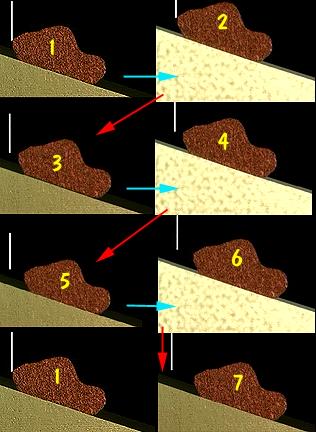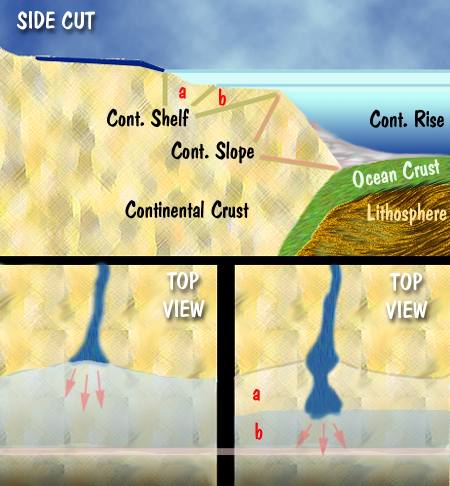
Frost heaving is the process of freezing and unfreezing over and over on a slope. Water trapped in the open pore area crystallizes and expands, it raises the regolith by the expansion. As the temperature increases, the regolith once again settles, but the expansion and contraction slowly move material down slope with the aid of gravity.
Repeated episodes of freezing and thawing will slowly move material down the slope.
Freeze cycles in blue arrow direction. Thaw cycles in red arrow direction. Rock is lifted up by expanding soil during freeze cycle. The direction of lift is up and to the right.
As it thaws out again the direction of drop is more nearly straight down, and this provides a slight offset.
In places where permafrost is present year round, only the top layer of soil thaws in the summer. This layer becomes saturated with water, and unstable.
With the aid of gravity this process moves large amounts of material down slope, usually slowly, but consistently.

Processes very similar to those on land also happen under the ocean especially near the base of continents.
Because the ocean sediment is very fine and is always saturated with water, the mass wasting process can occur on slopes with gradients as low as 1%.
The continental shelf is defines as the high and low point for ocean contact on a continent. It changes from time to time as the ocean shrinks or expands.
Rivers that reach the ocean cut a trough into the shelf and release the sediment to be sorted by the shelf and slope. Currents are created by the movement of water down slope from the river mouth which aid in the sorting and movement of the mass.
When the ocean has receded, the river will move further out onto the shelf and cut new channels downward that aid in increasing the slope, and move materials more rapidly on to the continental slope. This will increase mass wasting at the steeper slope and may create large valleys outward.
During the late ice age the sea was substantially lowered, and when the ocean returned, (the ice melted from the land) and the resultant rock and material from the ice was washed into rivers and streams and much of it was deposited into the ocean. As a result the Northern Atlantic coast line around the United States has vast deposits of rock and silt that have been built up along the continental slope.
These are covered with submarine valleys which increase gradient over short spaces, and thus promote more slumping and debris flows.
| NEXT | TOC | PREV |